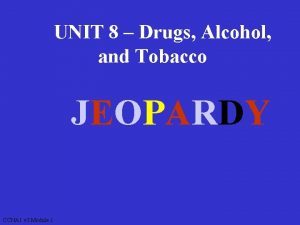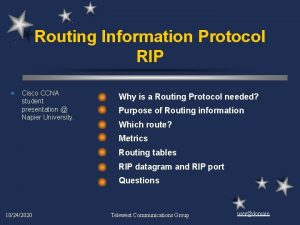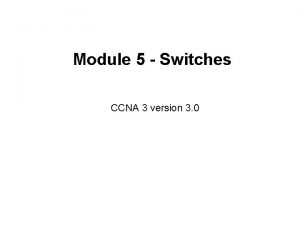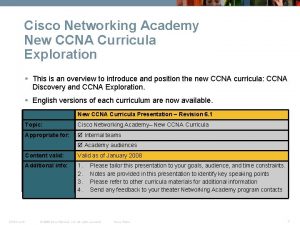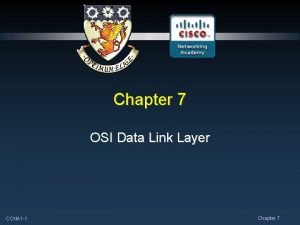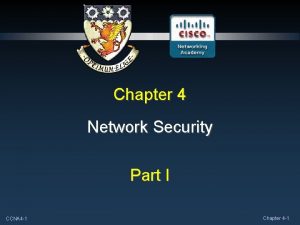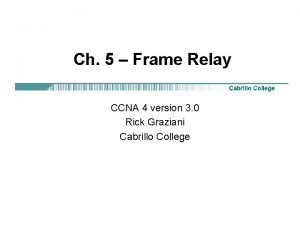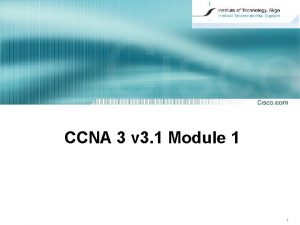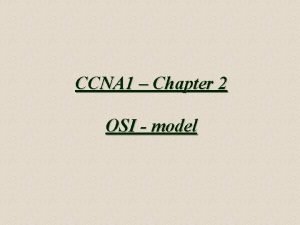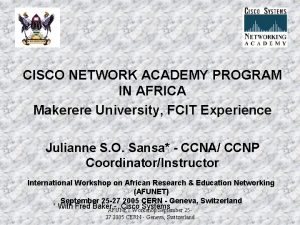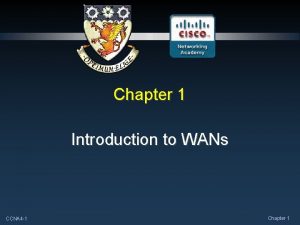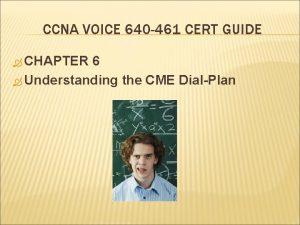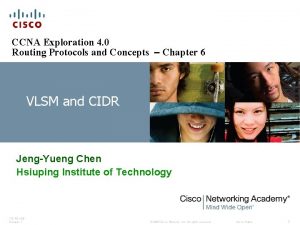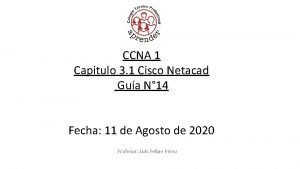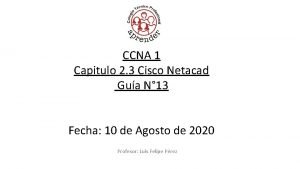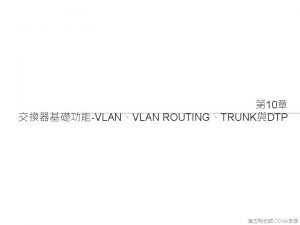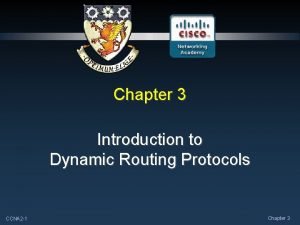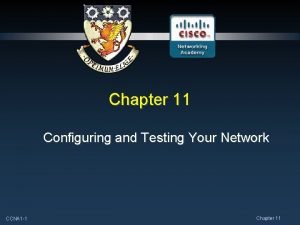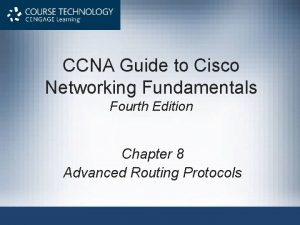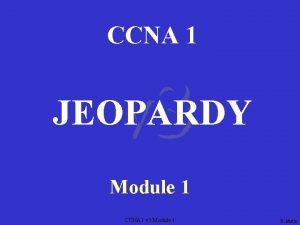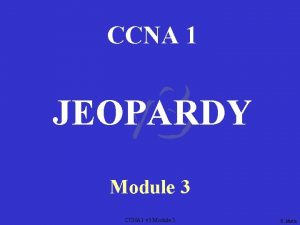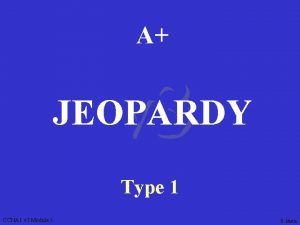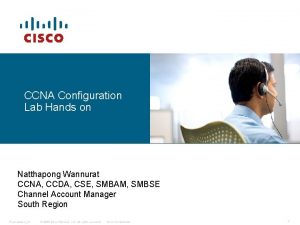A v 3 JEOPARDY Type 3 CCNA 1



























- Slides: 27

A+ v 3 JEOPARDY Type 3 CCNA 1 v 3 Module 9 K. Martin

Router Type 3 a Modes Router Type 3 WANType 3 Router Type 3 Type. WAN 3 Type 3 b c Services d f Encapsulation Basicse Commands ►►► Final Jeopardy ◄◄◄ 100 100 100 200 200 200 300 300 300 400 400 400 500 500 500 CCNA 1 v 3 Module 9

Type 3 a 100 When leak testing a low pressure centrifugal with nitrogen, what is the maximum test pressure? Question A: 10 psig. CCNA 1 v 3 Module 9 100 100 100 200 200 200 300 300 300 400 400 400 500 500 500

Type 3 a 200 Charged low pressure refrigeration machines may be most efficiently leak checked by. . . Question A: Raising system pressure by heating with circulated hot water or heating blankets. CCNA 1 v 3 Module 9 100 100 100 200 200 200 300 300 300 400 400 400 500 500 500

Type 3 a 300 A hydrostatic tube test kit will. . . Question A: Determine if a tube leaks. CCNA 1 v 3 Module 9 100 100 100 200 200 200 300 300 300 400 400 400 500 500 500

Type 3 a 400 Where would you place a leak detector probe to check gas leaks into the water box with water removed? Question A: Through a drain value. CCNA 1 v 3 Module 9 100 100 100 200 200 200 300 300 300 400 400 400 500 500 500

Type 3 a 500 EPA regulations require that all appliances containing MORE than 50 pounds Of refrigerant (except for commercial and industrial process refrigeration) be repaired when the leak rate ____ percent of the charge per year. Question A: 15%. CCNA 1 v 3 Module 9 100 100 100 200 200 200 300 300 300 400 400 400 500 500 500

Type 3 b 100 EPA regulations require that leaking commercial and industrial process refrigeration be repaired when the leak rate exceeds ____ percent of the charge per year. Question A: 35%. CCNA 1 v 3 Module 9 100 100 100 200 200 200 300 300 300 400 400 400 500 500 500

Type 3 b 200 R-11 or R-123 system refrigerant removal stars with. . . Question A: Liquid removal. CCNA 1 v 3 Module 9 100 100 100 200 200 200 300 300 300 400 400 400 500 500 500

Type 3 b 300 Why do chillers using CFC-11 and HCFC-123 require purge units? Question A: System operates below atmospheric pressure. CCNA 1 v 3 Module 9 100 100 100 200 200 200 300 300 300 400 400 400 500 500 500

Type 3 b 400 When removing oil from a low pressure system, the temp. should be 130 degrees Fahrenheit because. . . Question A: Less refrigerant will be contained in the oil at the higher temp. CCNA 1 v 3 Module 9 100 100 100 200 200 200 300 300 300 400 400 400 500 500 500

Type 3 b 500 During vapor removal from a low pressure refrigeration system the system water pumps, recovery compressor, and the recovery condenser should all be: Question A: What is ON? CCNA 1 v 3 Module 9 100 100 100 200 200 200 300 300 300 400 400 400 500 500 500

Type 3 c 100 Water must be circulated through a chiller during refrigerant evacuation in order to. . . Question A: Prevent freezing of the water. CCNA 1 v 3 Module 9 100 100 100 200 200 200 300 300 300 400 400 400 500 500 500

Type 3 c 200 Charging refrigerant liquid into a refrigeration system under a 29 in. Hg. vacuum can cause the. . . Question A: System water to freeze. CCNA 1 v 3 Module 9 100 100 100 200 200 200 300 300 300 400 400 400 500 500 500

Type 3 c 300 How do you determine when enough vapor has entered the refrigeration system before you charge refrigerant liquid? Question A: Refrigerant saturation temp. increases to 36 degrees Fahrenheit. CCNA 1 v 3 Module 9 100 100 100 200 200 200 300 300 300 400 400 400 500 500 500

Type 3 c 400 After reaching the required recovery vacuum on an appliance, you should. . . Question A: Wait a few minutes to see if the system pressure rises, indicating that there is still refrigerant in liquid form or in the oil. CCNA 1 v 3 Module 9 100 100 100 200 200 200 300 300 300 400 400 400 500 500 500

Type 3 c 500 Which of the following repairs would always be considered “major” under EPA’s regulations? 4 Question A: Replacement of an evaporator coil. CCNA 1 v 3 Module 9 100 100 100 200 200 200 300 300 300 400 400 400 500 500 500

Type 3 d 100 Appliances need not be evacuated all the way to the prescribed level when. . . Question A: Leaks in the appliance make evacuation to the prescribed level unattainable. CCNA 1 v 3 Module 9 100 100 100 200 200 200 300 300 300 400 400 400 500 500 500

Type 3 d 200 Under EPA’s regulations, which of the following methods can be used to pressurized on R-11 or R-123 system for a non-major repair? . Question A: Warming the refrigerant. CCNA 1 v 3 Module 9 100 100 100 200 200 200 300 300 300 400 400 400 500 500 500

Type 3 d 300 When using recovery or recycling equipment manufactured BEFORE Nov. 15, 1993, technicians must evacuate low-pressure appliances to the following level before making a major repair. Question A: 25 inches of Hg. Vacuum. CCNA 1 v 3 Module 9 100 100 100 200 200 200 300 300 300 400 400 400 500 500 500

Type 3 d 400 When using recovery or recycling equipment manufactured AFTER Nov. 15, 1993, technicians must evacuate low-pressure appliances to the following level before disposing of the appliance. Question A: 25 mm of Hg Absolute. CCNA 1 v 3 Module 9 100 100 100 200 200 200 300 300 300 400 400 400 500 500 500

Type 3 d 500 Approximately how much refrigerant vapor is left in an average 35 or 350 ton R-11 chiller at 0 psig pressure once all the R-11 liquid has been removed? Question A: 100 lbs CCNA 1 v 3 Module 9 100 100 100 200 200 200 300 300 300 400 400 400 500 500 500

Type 3 e 100 A centrifugal chiller rupture disk is connected to the chillers. . . Question A: Evaporator. CCNA 1 v 3 Module 9 100 100 100 200 200 200 300 300 300 400 400 400 500 500 500

Type 3 e 200 ASHRAE standard 15 -1994 requires the use of room sensors and alarms to detect. . . Question A: Refrigerant leaks. CCNA 1 v 3 Module 9 100 100 100 200 200 200 300 300 300 400 400 400 500 500 500

Type 3 a 300 R-11 at a pressure of 18. 1 inches Hg vacuum has saturation temperature of: Question A: 32 degrees Fahrenheit. CCNA 1 v 3 Module 9 100 100 100 200 200 200 300 300 300 400 400 400 500 500 500

Type 3 e 400 Which of the following are safety precautions for low pressure system? (Choices: Don’t siphon liquid refrigerant by mouth, Avoid spilling liquid refrigerant on the skin, Use gloves and safety goggles when working with liquid refrigerant) Question A: All of the above. CCNA 1 v 3 Module 9 100 100 100 200 200 200 300 300 300 400 400 400 500 500 500

Type 3 e 500 Under what code group of ASHRAE standard 34 does R-123 fall? Question A: B 1. CCNA 1 v 3 Module 9 100 100 100 200 200 200 300 300 300 400 400 400 500 500 500
 Drug and alcohol jeopardy
Drug and alcohol jeopardy Ccna roadmap
Ccna roadmap Ccna 640
Ccna 640 Rip student
Rip student Ccna 3 chapter 1
Ccna 3 chapter 1 Cisco ccna exploration
Cisco ccna exploration Ccna 7 layers
Ccna 7 layers Ccna 4 chapter 7
Ccna 4 chapter 7 Ccna 4 chapter 4
Ccna 4 chapter 4 Modern network security
Modern network security Frame relay ccna
Frame relay ccna Ccna exploration network fundamentals
Ccna exploration network fundamentals Ccna7
Ccna7 Ccna module 1
Ccna module 1 Osi model ccna
Osi model ccna Ccna makerere university
Ccna makerere university Eigrp ccna
Eigrp ccna Ccna 4 chapter 1
Ccna 4 chapter 1 Ccna voice 640-461 pdf
Ccna voice 640-461 pdf Ccna exploration 4
Ccna exploration 4 Netacad que es
Netacad que es Netacad ccna 1
Netacad ccna 1 Inter vlan routing教學
Inter vlan routing教學 Ccna 640-802
Ccna 640-802 Ccna 2 chapter 3
Ccna 2 chapter 3 Ccna chapter 11
Ccna chapter 11 Ccna guide to cisco networking
Ccna guide to cisco networking Ccna5
Ccna5
